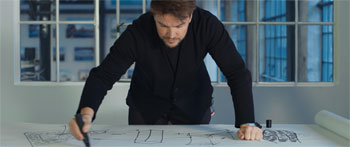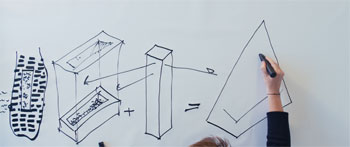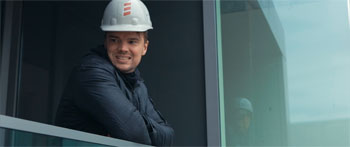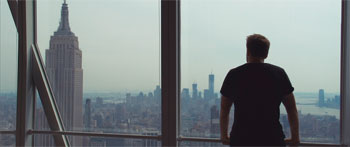Bjarke Ingels Big Time

Bjarke Ingels Big Time
Director: Kaspar Astrup Schroder
Genre: Documentary
Running Time: 93 minutes
Synopsis: Bjarke Ingels started out as a young man dreaming of creating cartoons. Now, he has been named 'one of architecture's biggest stars" by The Wall Street Journal. BIG TIME follows Bjarke during th ecourse of 5 years (2011-2016), while he struggles to finish his biggest project so far. We are let into Bjarke's creative processes as well as the endless compromises that his work entails, and we are on the side when his personal life starts putting pressure on him, too.
Bjarke Ingels' company Bjarke Ingels Group (BIG) has been given the task of designing and building one of the skyscrapers, which will replace the Twin Towers, which collapsed on the 11th of September 2001 in Manhattan. While Bjarke is creating a building, which will change the New York skyline, he is hit by health-related issues. The Film offers an intimate look into the innovative and ambitious Danish architect, whom the entire world is celebrating as a genius.
Big Time
Release Date: October 21st, 2017
About The Production
Nothing in this world is free.
This might be the mantra by which the Danish architect Bjarke Ingels lives. Bjarke is a proclaimed genius worldwide, but nevertheless, he leads a life, which leaves little room for privacy. Perhaps because of this, he values it highly and works hard to protect it.
The danish director Kaspar Astrup Schröder has followed the Danish star-architect over the course of five years. Most people know Bjarke Ingels for his work, but the film BIG TIME gets up and close to the person that is Bjarke Ingels.
What has been the cost of his success? With whom has he chosen to share it? What about love? Does his life leave any room for it? These are some of the questions that the film focuses on - questions that surround everyone in contemporary society. What happens when your health is threatened? What does the success and hard work mean then?
 Charafters:
Charafters:Bjarke Ingels' parents live in a classic Danish modernistic house north of Copenhagen, and this is where Bjarke grew up. It is a humble home, but with a great view of a forest and a lake to one side and the ocean to the other. This influence has been an ongoing clear inspiration in everything that Bjarke creates.
All of Bjarke Ingels' partners are some of his best friends, and he has managed to build an empire with partners, who each have their own strengths, and whom Bjarke compliments and values deeply.
Douglas Durst (b. 1944), the head of The Durst Organization, joined the powerful family business in 1968 while being taught by his father, Seymour, and his two uncles, Riy and David. The Durst-family has most certainly left their mark on the Manhattan skyline, especially in the area around Midtown. Douglas is a well known environmental activist, and he is behind the construction of New York's first and most environmental skyscrapers: 4 Times Square (2000) and The Bank of America Tower (2010). He is the brother of Robert Durst, who plays a central role in the tv-serie The Jinx.
Larry Silverstein (b. 1931) is an investor in property and the founder of the property company Silverstein Properties Inc., which administrates 37161 square kilometers of office-, living-, hotel- and detail-space in New York, and which has been announced as 'Best Places to Work in New York City" by Crain's New York Business. In 1997, Silverstein left his partner, Bernard Mendik, and bought several big office buildings in Midtown and Lower Manhattan, among others the World Trade Center in 2001, which he signed and purchased only few weeks before 9/11 and the collapse of the towers.
Director's Intention:
Architecture has always fascinated me. Nevertheless, I have had a hard time being fascinated by films about architecture, because I felt like they were either just pretty pictures or geeky anthropological films directed towards architects. I have wanted to convey architecture in a different and more cinematic way, making it about universal feelings and the people involved. I know Bjarke Ingels through my girlfriend, who started as an intern and later became an architect at his firm. I have known Bjarke for a long time. I met him through my girlfriend, who started as an intern and later became an architect in his company. I have a lot of friends who are architects as well as my sister. Had I not become a film director, I believe that I would have become an architect, too.
I knew Bjarke and his logical way of conveying things: a crystal clear narrative, which in some naivistic way makes complete sense. His buildings are very much about storytelling, and thus i thought that him and his work might be a good cinematic centerpoint for a film about architecture, which would finally be more like the ones in my mind. When he told me about a possible adventure in New York and the project into which he was going to indulge fully, I followed. From then, the film evolved into a film about Bjarke's development from local Danish up-and-coming architect into one of the world's most innovative creators.
First of all, Bjarke's business in New York evolved incredibly quickly. In fact, it evolved with so much speed that I couldn't be there for everything that was happening, so it has been a challenge to follow everything that was going on at the company. At the same time, I was discovering how much pressure Bjarke was under. It was as if he had put himself in the driver's seat in a train, which could never stop, and now he had to lay the tracks while managing the steering wheel. Then, some health-related issues arose, and the pressure became even bigger - that's when I started feeling that the film had the potential of becoming even more universal. That it didn't 'only" have the potential of conveying interesting architecture as well as the fascinating brain behind all of it, but it could also paint the greater picture of the modern man and the choices, he has to make in order to find happiness. A picture of how the little things in life - close relations, love and health - might be more important than we presume.
Since we already knew each other, the access had already been established, but Bjarke is generally very open, generous and giving. He is completely down to earth, and the six years in which I have been following him have not changed him one bit. One might think that all this fame and glory would get to his head, as it has with so many people before him, but that is not the case. On the contrary, it is almost as if he puts an honour in staying grounded and listening to those around him. This is especially obvious in the office, where the best idea always wins - not the boss' personal opinions or ideas, although I would say that Bjarke usually has the key to the solution of most problems that arise.
The challenge in filming was gaining access to Bjarke when he was alone, and especially at times that he was not working. Bjarke is always working. To be able to catch him on his own, where his mind is not on all the projects, is rare, thus I had to gear myself with patience and stay close in order to get into his most intimate space.
My goal has been to give an exclusive look at Bjarke Ingels - one, which we rarely see in other, swiftly produced cinematic portraits of him. A look into his world of creation ang change, where dreams can come true, but where the audience also understands just how much talent, courage and sacrifice it takes.
Furthermore, the film gives an exclusive access to one of Denmark's biggest stars and one of the world's greatest architects. We are let in under the surface, not only into his professional brain, but also his personal life. On the surface, Bjarke Ingels' life may seem like a piece of cake, but the film conveys some of the many challenges that follow with a life as one the world's greatest living architects.
I hope the film can tell a story about architecture, where the audience is also motivated and inspired to reflect upon their own existence - not only on a materialistic level (what kind of house they live in or such), but also on a greater level - what kind of life do they want to live? What does the career really mean in relation to the close relations? I hope the film and the invitation into Bjarke's life can be a catalysator for the audience's own thoughts about life - both concretely on a daily basis, but also on a greater level.
 Statement From Bjarke Ingels About The Film:
Statement From Bjarke Ingels About The Film: "I got to know Kaspar Astrup Schröder - first through his wife Em, whom I worked with in several laps both on PLOT and BIG - and then because he made a movie about Parkour, which turned out be more about more Architecture, about the city and how we use it. In this connection we met several times - Kaspar was out and filming at the Mountain and the 8-tallet and joining our Expo Pavillon in Shanghai and we had some inspiring conversations about what kind of frames the city offers our lives - how Parkour practitioners - or freebies - blow out the frames - or expand them - because they can jump higher than others. What we do at BIG is in many ways about expanding the framework by thinking them differently and making them more accommodating than you might normally do. Then when Kaspar came and asked if he could follow me for a year or two, I was in no doubt that it could only be a good thing.
Kaspar is a bit of a Renaissance man. He himself is a designer - he has done the graphics for many of his things - incl. BIG TIME - and he's a one-man army with his camera and microphones. we have now participated in other recordings, where there are sometimes 10 people present, who almost fills more than what they have to catch on film. Kaspar is always just himself and his camera - and although the production looks like a big setup job - it's only him on the spot (or a few times, René) - and because he has become such a very good friend, you are almost forgetting That he is there - and therefore he has also got some things in the box that I might not normally have thought fit for the canvas.
I think architecture is one of the most exciting things you can work with as a human being, because it basically is about how we would like to decorate the framework of our lives. What kind of life we want to live. And how do we create the best possible framework for ourselves and each other in the limited space that our planet is. But for some reason it has rarely managed to capture the majority's attention, commitment or imagination. So I was interested in how to make something that was engaging. Kaspar was interested in making something that felt like movies rather than reportage - no interviews, a chronological story, a story arch, beginning a middle and an end. I thought it sounded like something that could be interesting for people spending an hour and a half of their lives - if we could get people to get a little deeper interest in the fact that architecture is about much more than ugly or pretty, or red Brick or gray concrete. The film has become completely different than I imagined. First, 7 years suddently went by! I moved to the US shortly after Kaspar started filming. I turned 40. Our drawing room grew from 80 to 440 men. My world exploded in a lot of cool ways - many of my dreams really began to come true. But also in the way that when you say, "Take care of what you wish for, you might get it," then it's also true that once you get all the opportunities you've dreamed of, your calendar gets flled up, and your head and your life. And this is also what Kaspar has tried to capture.
Now you have to remember that in the end this is a movie Kaspar has made. Kaspar has shot over 70 hours. 60,000 hours has passed since he started. And there is a 90 minute film. So Kaspar has chosen to tell just the story - out of the many thousands of stories he could have told, wich is also a true story - but it's one of many possible. When he invited me into the editing room to see what is very close to the final result - I had NO idea what to expect. And that was not what I expected - or feared. I think it's a beautiful and authentic story - which clearly contains a part of what my world has been full of, and my mind has worked arround and my heart has been beating for - over the last 7 years. I can not judge whether it will be relevant or interesting to anyone other than me and my closest who is in the film. But we will get answers soon. My personal ambition is to make people spend 90 minutes in a world full of architecture and full of dreams and ideas and struggles and conflicts, and defeats and victories, and compromises and insistence and wishes and sacrifices , Which must be done to get a house up. And at that time, a greater interest and respect and ownership for the physical environment of our society, which is so important to the life we live - but as we often forget – its difficult to see the forest for just trees.
I had hardly anticipated anything like that, that happens in the film. I had not even planned to move to New York. Jeg havde ikke drømt om, at vi skulle komme til at tegne den sidste World Trade Center tårn. Og jeg havde bestemt ikke set et baseballbat komme flygende ... "
Jeg havde næppe forudset noget som helst af det der sker i filmen. Jeg havde ikke engang planlagt at flytte til New York. I had not dreamed that we should draw the last World Trade Center tower. And I certainly would not have seen a baseball bat come flying ... "
Facts About Bjarke Ingels:
Bjarke Ingels (born 2nd of October 1974 in Copenhagen) is a Danish architect and the leader of the architectural firm Bjarke Ingels Group (BIG), which has created some of the most notable buildings around the world. He graduated from the Royal Danish Academy of Arts in Architecture.
PLOT was founded by the two young architects Bjarke Ingels and Julien de Smedt. They first met at Rem Koolhas' architectural firm in Rotterdam, and they subsequently founded their own firm with the goal of evolving an architectural practice based on detailed prior analysis of practical and theoretical foundations and relations.
PLOT won several competitions and Architecture Prizes. For instance, the VM Buildings were awarded with the Swedish architectural magazine Forum's Architecture prize for the best Nordic building in 2005, and it has received the Copenhagen Municipality's architecture prize in 2006. Furthermore, they created the swimming port in Islands Brygge in Copenhagen and the Maritime Youth house.
In 2005, the two founders dissolved the firm.
In 2006, Bjarke Ingels founded his own firm, BIG - Bjarke Ingels Group, which is behind further two prominent buildings in Copenhagen: The Mountain Dwellings (2008) - a ten storey livingspace with an indoor parking lot, places next to the VM Buildings, trying to combine garden areas with storey buildings - and the bow-shaped 8TALLET (2010), which consists of different kinds of apartments and offices, tied together by a 1 kilometer long footpath, which meanders around and on top of the building.
Furthermore, BIG has created the Danish pavillon at the World Exhibition EXPO 2010 in Shanghai and the Maritime Museum in Helsingør (which opened in 2013).
A project of a 142 meter tall building with living spaces in Manhattan in New York (VIA West 57 project) started in 2010 and finished in 2016 - a building, which was awarded and celebrated for having redefined the New York skyline, and in 2011, the firm won competition for doing a National Gallery of Art in Nuuk, Greenland, together with the architectural firm TNT Nuuk. Since 2009, Bjarke Ingels has won several architectural competitions. In October 2011, the Wall Street Journal named him the Innovator of the Year for Architecture. He moved to New York in 2012, where BIG, besides having designed the VIA apartments, won a design competition for improving the flood protection of Manhattan after Hurricane Sandy. Furthermore, BIG is designing the new Two World Trade Center building.
Important buildings and projects:
· 8Tallet, Ørestad, Copenhagen
· Odense Aqua Center
· Mountain Dwellings, Ørestad, COpenhagen
· Sjakket, Copenhagen
· Helsingør Psychiatric Hospital
· VM Buildings, Ørestad, Copenhagen
· The Maritime Youth house, Amager, Denmark
· Islands Brygge Havnebad/Swimming Port, Islands Brygge, Copenhagen
· Superkilen, Copenhagen
· VIA West 57 project, Manhattan, New York
· Two World Trade Center, New York
 Facts About Big:
Facts About Big:BIG is a firm, which uses thorough research and analysis of practical and theoretical issues as a foundation for developing architectural solutions. BIG consists of architects, city planners, designers and other experts. The firm works with housing projects, offices, culture, education, hotels, hospitals, infrastructure and city life all over the world from their offices in Copenhagen, New York City and London.
They create buildings, which are both functional and innovative, while being very aware of costs and saving resources. BIG always starts out with a thorough analysis of the place, the context and the program, as a starting point for further work. BIG has recently completed projects like West 57th - a housing building with 750 apartments in Manhattan (2016), The Maritime Museum of Denmark (2013), Superkilen in Copenhagen (2012), 8TALLET in Copenhagen (2010), all of which have received international praise as well as prizes for their visionairy architecture. The firm's first project, the Copenhagen Swimming Port (Københavns Havnebad, 2003) played a crucial part in transforming the city space around Islands Brygge in Copenhagen, from one of the worst industrial areas of the city into a recreational and social center.
Selection of current projects: Vancouver House - a development project in Canada, the masterplan for Smithsonian Campus in Washington D.C., an educational center in the Faroe Islands, Shenzhen Energy Mansion in China, the Museum Center Blåvand, LEGO House in Billund and Amager Bakke in Copenhagen - an energy center, which also functions as a ski slope.
Big Time
Release Date: October 21st, 2017
MORE
- Mission: Impossible Fallout
- Glenn Close The Wife
- Allison Chhorn Stanley's Mouth Interview
- Benicio Del Toro Sicario: Day of the Soldado
- Dame Judi Dench Tea With The Dames
- Sandra Bullock Ocean's 8
- Chris Pratt Jurassic World: Fallen Kingdom
- Claudia Sangiorgi Dalimore and Michelle Grace...
- Rachel McAdams Disobedience Interview
- Sebastián Lelio and Alessandro Nivola...
- Perri Cummings Trench Interview



